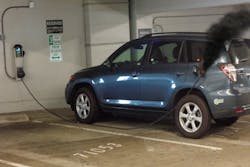University of Extrication: Plug-In Vehicle Charging Stations
Subject: Plug-In Vehicle Charging Stations
Topic: Charging Station Emergencies
Objective: Understand the risks present during charging station emergencies
Task: The fire/rescue team shall develop procedures for safely & efficiently dealing with various types of plug-in electric vehicle charging station emergencies
As increasing numbers of plug-in hybrid and electric vehicles are purchased by citizens within your response district, the possibility of fire/rescue personnel encountering a charging station emergency becomes more likely. Alternating current (AC) electricity flows out of the charging station, through the charging cable and connecting plug, and into the charging port receptacle mounted on the vehicle. Inside the vehicle, the AC power is converted to direct current (DC) to charge the high-voltage battery.
Charging stations may be small wall-mounted units or larger free-standing pedestal design. They can be found on a wall in a resident’s garage, in a retail or commercial store parking lot, inside a multi-story parking garage, along a city street, or at a public charging station facility along a major highway. Charging stations come in various models, designs, sizes and voltages. A Level 1 charger involves a 110-volt, 15–20 amp household electrical AC circuit. Level 2 charging stations utilize 240-volts at upwards of 80 amps. The fastest plug-in vehicle charging occurs with Level 3 units; 480-volt, 125+ amp systems.
Built-in safety features of the charging station will typically include a charge circuit interruption shutdown device, an electrical ground monitoring circuit feature and an automatic shutdown feature if the charging cable itself is snagged and strained. In addition, training for emergency responders is available from several sources, the most immediate of which may be the manufacturer and/or installer of the charging station itself. Most hybrid/electric vehicle fire service training programs, such as those offered by the NFPA, address the challenges of charging station emergencies within their curriculum.
Charging station emergencies that fire/rescue personnel must prepare for can include encountering a fire within the charging station unit itself. A fire can also develop within the vehicle while it is connected to a charging station. At a residential structure fire, responders may encounter a vehicle inside the garage plugged into a Level 1 or Level 2 charging station. In this case, the home circuit breaker can be used to shut off the power.
In addition, a crash may cause physical damage to a pedestal-type charging station where an occupied vehicle may be found in contact with the damaged charging station unit when you arrive on scene.
Responders can use the fire-based scenarios described in the captions to begin developing procedures for dealing with charging station emergencies within their response district. Remember, AC current flows through the charging station and through the connected power cable to the receptacle on the vehicle. If this side of the charging process is affected by the emergency, it should be treated as a “wires down” incident would be handled. Get the power shut down remotely before you move in and take any action with the charging station or the vehicle. Also, several charging station designs incorporate solar power to supply electricity to the charging station. Make sure that ALL electrical power is shut down before committing personnel to contact the station or the vehicle.
Sidebar: Recommended Tactics When Dealing with a Charging Station Emergency
- Isolate and secure the immediate area
- Request power shutdown
- Protect exposures
- Chock wheels of vehicle if safe to do so
- Initiate additional activities as appropriate once power is confirmed shut off to the charging station
About the Author
Ron Moore
RON MOORE, who is a Firehouse contributing editor, recently retired as a division chief with the McKinney, TX, Fire Department and now serves with Prosper, TX, Fire Rescue. He self-published the Vehicle Rescue 1-2-3 training manual and serves as the forum moderator for the extrication section of Firehouse.com . Moore can be contacted directly at [email protected].

